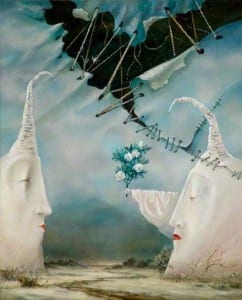As with all practical performances and projects, we have been experimenting with ideas to see what works and can be used in our final piece. Trial and error is an important part of our practical development.
We watched footage of fruit decomposing, and liked the idea of how time can effect an object very visually, with photography and media as a means of recording time itself. The next stage of this was having to decide how we could do this ourselves in the simplest and most practical way. We discussed leaving a pineapple in a shed or somewhere uninterrupted, where we could focus a camera on it and film its decomposition. The significance of the pineapple is that it is a feature of our chosen performance space of Gallery 3.
However, this caused us practical concerns, and raised many questions over how long it would take to decompose and whether we could get a camera for that amount of time.
Instead we decided to cut a pineapple in half and see what would happen if we left it in a cupboard for a few days and took a few photos over the duration.
Would it change its appearance over one weekend? Or would it take weeks for any effects to take place?
This is the experiment I am recording so far. And this is the result after 3 days of a pineapple in my cupboard…….

This is a simple stop-frame style animation I have created of the decomposition process so far. As you can see, the pineapple has started to change texture and colour. Something visual such as this, could be used as an aid in our final performance piece to show the effects that time can have.

